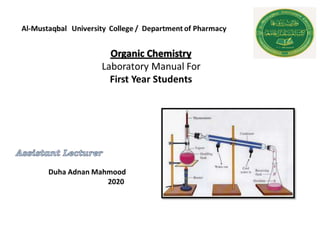
Determination of boiling point and distillation
- 2. Experiment name 4/Distillation Introduction – Since organic compounds do not usually occur in pure condition in nature, and are accompanied by impurities when synthesized, the purification of materials forms an important part of laboratory work in chemistry. Four general separation procedures are used frequently in organic work in the laboratory and in industry: distillation, chromatography, crystallization, and extraction. The process used in any particular case depends upon the characteristics of the substance to be purified and the impurities to be removed. In order to select the most appropriate process and to employ it effectively it is important that the student understand the principals involved as well as the correct methods of manipulation. Simple distillation is one of the most commonly used purification methods.
- 3. Distillation It is a process of separation & purification of liquidorganic compounds by selective evaporation & condensation. It may result in complete separation ( nearly pure ) , or, a partial separation that increase the concentration ofselected compound of the mixture The temperatures at which a liquid distills is a definite value at a given pressure , for every pure organic compound called boiling point
- 4. Aim of the Distillation: 1- Purification of liquid organic compound. 2- Determination of the boiling point. 3- Separation of liquid organic substances from each other or from a non volatile solid compounds Types of distillation: 1- Simple distillation. 2- Vacuum distillation. 3- Steam distillation. 4- Fractional distillation. 5- Reflex.
- 5. Simple Distillation : A simple distillation apparatus is shown in Figure 1. This consists of a round-bottomed flask connected by means of a distillation adapter to a water-cooled condenser. A thermometer is held in place in the vertical arm of the distillation adapter by a special rubber connector at a height adjusted so that the top of the thermometer bulb is 5 – 10 mm below the opening of the side-arm. A (vacuum) adapter is connected to the lower end of the condenser. The distilled liquid is collected in a clean, dry receiver, commonly an Erlenmeyer flaks or small mouthed bottle. To reduce vapor losses and minimize fire hazards, it is desirable to insert the lower end of the adapter well into the mouth of the receiver. A distilling assembly must have an opening to the atmosphere to avoid developing a dangerously high pressure within the system when heat is applied.
- 6. vacuum Distillation The vapors generated in the pot rise up the fractionating column and encounter cooler surfaces, upon which they condense (see Figure2). Some compounds have very high boiling point or unstable to heat. To boil such compounds it is better to lower the pressure at which such compounds are boiled instead of increasing the temp. Once the pressure is lowered to the vapor pressure of the compound , at a given temp., boiling & the rest of the distillation process can commence. This technique is referred to as vacuum distillation.
- 8. Steam Distillation: This method is used for the separation of water immiscible compound of low volatility from non- volatile tarry products which are formed as by-products in many reactions.
- 9. It is used to separate mixtures in which the components have boiling points that differ by only a few degrees, by employing a fractionating column in the distillation apparatus. So, fractional distillation is a process of collecting separate fractions according to controlled boiling ranges during the distillation of a mixture of substances. Fractional Distillation
- 11. Reflex Distillation: Reflex is a distillation technique involves the condensation of vapors & the return of this condensate to the system from which it originated. This method is used to keep or prevent the reactants from loss by evaporation during a reaction.
- 12. Name of experiment: Simple Distillation Aim of experiment: Purification of Ethanol Procedure: 1- Put 100 ml of ethanol in a boiling flask. 2- Add 2-3 pieces of boiling chips. 3- Start the water running slowly through the condenser. 4- Heat until boiling. 5- Adjust the temperature so that distillation proceeds at 2-3 drops per second. Discard the first 2-3 ml of the distillate. 6- Continue distillation until you collect 30-60 ml. 7- Record the boiling point of your liquid, Ethanol
- 13. * Pure compound's distill over a very narrow range oftemp. * The boiling point is affected by impurities; some may increase the boiling point, others may decrease it & some may not affectit. * Usually the 1st few milliliters of the distillate containwater or volatile impurities, 2nd portion contains thesubstance. * 2 – 3 pieces of brokenporcelain chips are placed in the boiling flask with the substance to be distilled to prevent bumping by producing a constant stream of bubblesthat keep the liquid in motion. * If the liquid is volatile ( low boiling point ), the flask is heated bya water bath rather than by a flame * Notes
- 14. Questions 1. Why is it necessary to add boiling chips to the round flask? 2. Considering your results, which method is better for separating acetone from ethanol, simple or fractional distillation? Justify your answer. 3. What is the purpose of the condenser? 4.In this lab you will separate a mixture of organic liquids by two methods; simple and fractional distillation. In theory, which method should give the better separation? Briefly explain why. https://youtu.be/2XBrj-ZEnEo